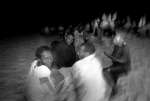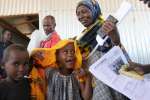- Text size
 |
|  |
|  |
| 
- Français
Somalia - Thousands fleeing deadly clashes in Mogadishu
Briefing Notes, 12 March 2010
This is a summary of what was said by UNHCR spokesperson Andrej Mahecic – to whom quoted text may be attributed – at the press briefing, on 12 March 2010, at the Palais des Nations in Geneva.
UNHCR is extremely worried about the worsening situation for the civilian population in Somalia which is, once again, exposed to relentless and indiscriminate fighting in Mogadishu and elsewhere in the country. We estimate that since the beginning of the year more than 100,000 Somali civilians have been forced to flee their homes across the country.
The latest fighting between government forces and the Al-Shabaab militia is concentrated in Mogadishu's northern suburbs of Shangaani, Cabdulcasiis, Yaaqshiid and Kaaraan. Since February, some 33,000 Somalis have been driven out of their homes by the continuing conflict in Mogadishu. Almost 14,600 of them fled to Afgooye corridor, a stretch of road some 30 kilometres west of Mogadishu. There, they are jammed in makeshift settlements which are already home to over 366,000 internally displaced people (IDPs). Thousands also fled to other parts of the country.
We are especially concerned about safety and well being of some 8,300 people who, without any means to get out of Mogadishu, remain displaced within the capital. As the fighting rages on, aid agencies cannot access and assist these extremely vulnerable IDPs.
Meanwhile in Kenya, nearly 10,000 new Somali refugees have been registered over the first nine weeks of this year. Considering the ongoing violence in Somalia, we fear that Dadaab refugee complex in northern Kenya, hosting already some 270,000 refugees, has yet to observe a significant increase in the rate of the new Somali arrivals.
Somalia remains one of the countries generating the highest number of displaced people and refugees in the world. There are more than 1.4 million IDPs in Somalia while over 560,000 Somalis live as refugees in neighbouring and nearby countries.














































